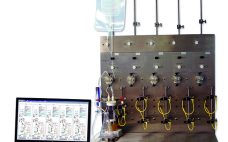Sales of monoclonal antibodies (MAbs) are predicted to be over US$125 billion by 2020 (1). Such revenue potential puts significant pressure on the biopharmaceutical industry to reduce timelines, especially to first-in-human trials. Cell-line development represents a large and critical portion of the early development timeline. Whether a developer is using random or targeted integration for introducing genes into a host-cell genome, the regulatory requirement for addressing monoclonality introduces a time and resource-intensive step in this process. Many different techniques are…
Analytical
Dye Ingress Methods for Container–Closure Integrity Testing: An Industry Position Paper
The primary goal of container–closure integrity (CCI) is to maintain the sterility and product quality of parenteral biopharmaceuticals throughout their shelf life and use. Guidelines detailing the initial CCI qualification and validation requirements have been defined and can be found in the US Pharmacopeia chapter 1207 (USP<1207>) (1). The guidelines described in USP<1207> can be applied to any common CCI testing (CCIT) method to achieve a method suited for its intended use within a drug product lifecycle. CCI is not…
Big Biotech Data: Implementing Large-Scale Data Processing and Analysis for Bioprocessing
Managing large amounts of data presents biopharmaceutical companies of all sizes with the need to adopt more efficient ways to handle the ongoing influx of information. At KNect365’s September 2017 Cell and Gene Therapy conference in Boston, Lisa Graham (founder and chief executive officer of Alkemy Innovation, Inc. in Bend, OR) spoke about the need for data management, data analysis, and process monitoring systems to evolve. Although she was speaking at a cell therapy event, her points are applicable to…
Virus Segregation During Purification Processes: Calculation of Critical Potential Carryover of Viruses
Before a pharmaceutical product is introduced into humans, either in a clinical trial or as a marketed product, virus safety must be evaluated carefully. Virus safety normally is ensured using a three step complementary approach: selecting and testing cell lines and/or raw materials for the absence of viruses, testing the product at appropriate steps of production, and assessing the capacity of a production process to clear infectious viruses (1). The latter (also referred to as viral clearance) is the subject herein. Spiking studies are conducted to evaluate the capacity of a purification…
A UF–DF Screening System for Bioprocess Development: Efficient and Cost-Effective Process Fit and Scale-Up to Manufacturing
Ultrafiltration and diafiltration (UF–DF) of therapeutic proteins are performed in either tangential or crossflow mode using membrane filters. UF–DF plays a critical role in both downstream and upstream processes for the biopharmaceutical industry (1). In upstream production processes, classical tangential-flow filtration (TFF) or alternating tangential-flow (ATF) systems are used in high–cell-density perfusion for protein expression by cell culture (2). TFF is used in downstream processing for UF–DF and concentration of therapeutic proteins. TFF unit operations are common in protein purification…
In-Line Turbidity Sensors for Monitoring Process Streams in Continuous Countercurrent Tangential Chromatography (CCTC)
A strong connection between turbidity and total suspended solids (TSS) has been linked in the past to measuring well defined particles in processes. Optical density probes have seen wide adoption in the biotechnology industry for monitoring cell growth within a bioreactor, whereas in-line turbidity sensors have been used to monitor filter performance. Turbidity measurements offer a rapid quantification of suspended solids but have not been used in the biotechnology industry for chromatographic resins. In this study, turbidity measured with equipment developed by PendoTECH was used with novel continuous chromatography technology developed by Chromatan…
Setting Up a Rapid Mycoplasma Assay to Support Recombinant Protein Production
Octapharma AB (OAB) in Stockholm, Sweden, is the site for Nuwiq human recombinant factor VIII (FVIII), production. The drug is produced in a human cell line cultured in a perfusion bioreactor using a closed system (to minimize contamination) and proprietary serum-free medium without animal-derived components. In accordance with regulatory guidelines, cell banks and cell cultures used for production of biological products must be free of mycoplasma. Traditional mycoplasma testing is a growth-based method that represents a significant bottleneck in quality…
Accelerating Biopharmaceutical Development with High-Throughput Glycan Screening and Multiple Attribute Methodology
Part 1 Development of biopharmaceuticals comprises many integrated steps, beginning with research and discovery and optimally ending with a commercial therapeutic molecule. Early screening of large numbers of clones and cell culture expression conditions is essential to identifying proteins that carry to greatest likelihood of clinical and commercial success. Part one of this report reviews how high-throughput glycan screening can significantly improve current analytical strategies relating to cell line development. Part 2 Minor impurities and changes in attributes such as…
Assurance of Clonality: Next-Generation Single-Cell Dispensing in Cell Line Development and Single-Cell Genomics
At the Cell Line Development and Engineering (CLD&E) conference(23–25 April 2018, Amsterdam), Jonas Schöndube, CEO of cytena GmbH, gave a presentation highlighting some of the company’s recent developments in single-cell dispensing for documented clonal cell lines. About cytena cytena is a young company dedicated to the development and manufacture of tools for the biopharmaceutical industry. In 2015, cytena launched the single-cell printer™ (scp™), which enables fully automated isolation of single cells into 96- and 384-well plates. The patented technology uses…
Single-Use Bioreactors: Performance and Usability Considerations Part 1: Performance for Process Control
There is ever increasing pressure for the biopharmaceutical industry to drive toward higher efficiency and lower costs. Compared to the past, target markets for many drugs typically are becoming smaller, and so-called blockbuster drugs are becoming more the exception than the rule. Regulatory agencies have continued to increase the pressure on drug makers to meet increasing quality standards and accept higher levels of responsibility. Furthermore, customer pricing, healthcare markets, and recent biopharmaceutical pricing scandals all add incentives toward more efficient…










